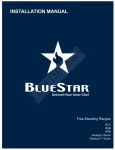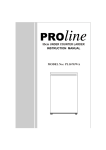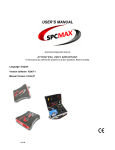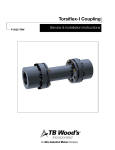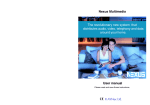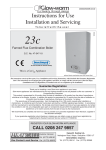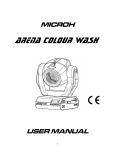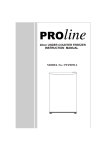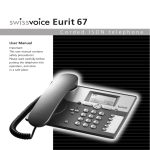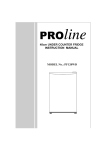Download Proline PUF110W Specifications
Transcript
Proline Instructions for use Model PFZ115WA PROline **** Upright Freezer PFZ 115 WA INSTRUCTIONS Thank you for buying this upright freezer. To ensure that you get the best results from your new freezer, please take time to read through these simple instructions in this booklet. Please ensure that the packaging material is disposed of in accordance with the current environmental requirements. If the fridge is visibly damaged, do not connect it to the power supply, Contact the store from were you purchased the appliance. ELECTRICAL CONNECTION For your safety please read the following information Warning This appliance must be earthed. This appliance operates from a 13 amp 3 pin plug. The voltage rating is 230 volts and should be protected by a 13 amp fuse in the plug. The appliance is supplied with a rewireable 13 amp 3 pin plug fitted with a 13 amp fuse. Should the fuse require replacement, it must be replaced with a fuse rated at 13 amp and approved to BS1362. If the mains plug which is fitted is unsuitable for the socket outlet in your home or is removed for any other reason, please follow the instructions below on how to wire a 13 amp 3 pin plug. How to wire a 13 amp plug. Important. The wires in the mains lead on this appliance are coloured in accordance with the following code: Green and Yellow – Earth Blue – Neutral Brown – Live As the colours may not correspond with the markings Identifying the terminals in your plug proceed as follows: The Green and Yellow wire must be connected to the terminal in the plug which is marked with the letter E or with the earth symbol or coloured green and yellow. The Blue wire must be connected to the Terminal marked N or coloured black. The Brown wire must be connected to the Terminal marked L or coloured red Control Unit Description of the Appliance Control unit Storage Baskets door Level Adjusters Control Unit NORMAL MAX MIN SUPER 4 USING THE APPLIANCE Do not use detergents, abrasive powders, highly perfumed cleaning products, wax polishes or products containing alcohol. T h i s a pp l i a n c e i s de s i g n e d f or domestic use only, specifically for the storage of edible foodstuffs. This appliance is designed to operate in ambient temperatures (surrounding air temperature) between 16 (50 F) and 32 To Start the Appliance 1. Allow the appliance to stand for 2 hours If these temperatures are exceeded i.e., colder or warmer, the appliance will not operate correctly. Should the ambient temperatures be exceeded for long periods, after installation. 2. Plug in the appliance and switch on at the the temperature in the freezer section will rise above -18 C and food spoilage may occur. setting. A midway setting is usually suitable mains supply. 3. Turn the thermostat control to the required for normal operation (see thermostat control). Before Use 4. Leave the appliance for approximately 4 Remove all securing tapes. Wash the inside of the appliance with lukewarm water with a little bicarbonate of soda added (5ml to 0.5 litre of water). Do not use soap or hours for the correct temperature to be reached before placing food inside. detergent as the smell may linger. Dry the appliance thoroughly. Thermostat Control The thermostat control situated in the control panel regulates the temperature of the freezer compartment. Position "Min" - Cold Position "Normal" - Colder.normally,setting at this position. Position "Max" - Coldest Position "Super" -To fast freeze food, the compressor will work continously. The temperature will be affected by: NORMAL MIN MAX SUPER Room temperature How often the door is opened How much food is stored Position of the appliance To determin the correct temperaure control setting, all these factors have to be considered and some experimentation may be necessary Do not allow children to tamper with the controls or play with the product. 5 INSTALLATION S I G H T I N G O F T H E A P P L I A N C E Do not keep your appliance in a room where the temperature is likely to fall below 12ºC (54ºF) at night, especially in winter, as it is designed to operate in ambient temperatures between +12 and +32ºC (50 and 90ºF). At lower temperatures the appliance may not operate, resulting in a reduction in the storage life of the food. Do not place the appliance near cookers or radiators or in direct sunlight, as this will cause extra strain on the appliance’s functions. If installed next to a source of heat or fridge, maintain the following minimum clearances. Choose a well-ventilated location with no less than 10cm clearance around the freezer. Place the freezer in a location with a firm base. In order to prevent vibration and excessive noise. Level the freezer by adjusting the two front feet. DO NOT PLACE THIS PRODUCT IN AN EXCESSIVELY COLD OR HUMID AREA S U C H A S A GARAGE OR CELLAR ETC. WAIT 24 H O U R S B E FO R E PL U G G I N G I N A N D S W I T C H I N G O N T H I S PR O D U C T . THE C O O L A N T F L U I D N E E D S TIM E T O SETTLE. DO N O T STORE F O O D IN T H E FREEZER U N T I L IT HAS BEEN R U N N I N G F O R A T LEAST 2 H O U R S . UNDER NO CICUMSTANCES MUST THE COOLANT CIRCUIT BE DAMAGED. THIS PRODUCT IS INTENDED FOR DOMESTIC USE ONLY, ANY OTHER USE MAY INVALIDATE THE WARRANTY AND MIGHT BE DANGEROUS If you are discarding an old appliance with a lock or catch fitted to the door, ensure that it is left with the door catch disabled and in a safe condition to prevent children getting trapped inside. We suggest you contact your local authority for information on the correct and safe method of disposal. Dispose of all packaging in an environmentally friendly way. Your freezer is suitable for the long-term storage of commercially frozen foods and can be used to freeze and store fresh food. If there is a power failure, do not open the door. Frozen food should not be affected if the failure lasts for less than 12 hrs. If the failure is longer, then the food should be checked and either eaten immediately or cooked and then re-frozen. NOISES INSIDE THE FREEZER If you have not owned a freezer before, you may notice that it makes some rather unusual noises. Most of these are perfectly normal, but you should be aware of them! GURGLING, WHOOSHING These noises are caused by circulation of refrigerant in the cooling system. It has become more pronounced since the introduction of CFC free gases. This is not a fault and will not affect the performance of your freezer. HUMMING, PURRING OR PULSATING This is the compressor motor working, as it pumps the refrigerant around the system. SHOPPING FOR FROZEN FOODS Your Freezer is 4 star. When you are buying frozen food, look at the Storage Guidelines on the packaging. You will be able to store each item of frozen food for the period shown against the 4 star rating. This is usually the period stated as ‘Best Before’, on the front of the packaging. CHECK THE FREEZER TEMPERATURE Check the temperature of the frozen food cabinet in the shop where you buy your frozen foods. It should show a temperature lower than -18°C. CHOOSE PACKS CAREFULLY Take a quick look at the frozen food package and make sure it is in perfect condition. PURCHASE FROZEN FOOD LAST Always buy frozen products last on your visit to the supermarket. KEEP FROZEN FOODS TOGETHER When you are going around the supermarket and when you are travelling home, if you keep all the frozen foods together they will help to keep each other cold. STORE FOOD STRAIGHT AWAY Don’t buy frozen food unless you can freeze it straight away. Special insulated bags can be bought from most supermarkets and hardware shops. These keep frozen food cold for longer. FREEZING FRESH FOOD Freezing 4Kg or more of fresh food. Set the temperature control to “Super” 24 hours before introducing the fresh food. 2 hours is sufficient for less than 2Kg of fresh food. The compressor will work continuously whilst on the “Super” setting. Return the temperature setting to normal after a further 24 hours, 2 hours if less than 2Kg. It is not necessary to use this setting when introducing ready frozen food. TO THAW FROZEN FOODS 1. Cover food loosely. 2. Thaw at room temperature. Don’t forget that thawing in a warm area encourages the growth of bacteria. 3. Always make sure there are no ice crystals in the food before cooking, particularly with meat. These crystals indicate that the food is not fully thawed. They result in lower temperatures when cooking. Lower cooking temperatures may not destroy bacteria. 4. Cook food as soon as possible after thawing. 5. Drain off and throw away any liquid lost during thawing. THAWING FROZEN VEGETABLES For some foods, thawing before cooking is unnecessary. Vegetables and pasta can be added directly to boiling water or steam cooked. Frozen sauces and soups can be put into a saucepan and heated gently until thawed. OVEN THAWING FROZEN FOODS Many microwaves and ovens have thaw settings. To avoid bacterial build up, only use these if you intend to cook the food immediately afterwards. SAFETY TIPS Never re-freeze anything that has thawed out unless you cook it again, to kill off harmful bacteria. Never re-freeze thawed shellfish. FREEZING FRESH FOOD (TIPS) Use quality food and handle it as little as possible. Freeze food in small quantities, it freezes faster, takes less time to thaw and enables you to eat it in the quantity you need. First, estimate the amount of food you will be freezing. Use the Thermostat Control Dial to make your freezer colder (about -30° C), it will therefore freeze quicker and keep in the goodness. However you should use it sparingly to conserve energy. PROLONGED OFF PERIODS If the refrigerator is not in use for a long period of time, proceed as follows: Disconnect the refrigerator from the main supply by removing the plug from the socket. Clean and dry the inside as instructed under the heading of cleaning the appliance. Leave the door open to prevent any unpleasant smells from building up while the appliance is not in use. If there is a power failure for a short time keep the door closed check the contents of the refrigerator every so often. POWER FAILURE If there is a power failure for a short time less than 16 hours keep the door closed Frozen food should not be affected if the failure lasts for more than 16 hours. Extra protection can be given by covering the appliance with two or three thick blankets. If a long power failure is anticipated, try to get the foodstuff into another appliance or cold store, if possible. If the power cut is longer than 16 hrs then check the content of the freezer. If the food has defrosted, cook and refreeze the food or it should be eaten immediately. Never refreeze food that as been defrosted. CLEANING AND MAINTENANCE Before any cleaning or maintenance is carried out you must disconnect the appliance from the mains supply by removing the plug, never remove the plug by pulling on the mains cord. Remove the plug by pulling on the plug itself. It is recommended that when cleaning the appliance, both the inside and outside, can be cleaned using warm water and a little bicarbonate of soda. Use 1 teaspoon to 1.2 liters of water Do not use detergents, abrasive powders, highly perfumed cleaning products, wax polishes or cleaning products containing bleach or alcohol. External Cleaning, wash the outer cabinet with warm soapy water. Do NOT use abrasive products. There are sharp edges on the underside of the product so care should be taken when cleaning. Once or twice a year dust the compressor at the back of the appliance, with a brush or Vacuum cleaner, as an accumulation of dust will affect the performance of the appliance and Cause excessive electricity consumption. Warning: The refrigerating system must not be damaged at any time. DEFROSTING THE FREEZER The freezer will need defrosting periodically (when the frost is more than 3mm thick). Turn the temperature control to “MIN” and unplug from the mains socket. Hold the plug itself. Do not remove the plug by pulling on the mains cord. Remove all the frozen food and wrap in thick blankets to retain the cold or move it to another freezer. Leave the freezer door open with a suitable container under the front to catch the water as the frost melts. When the freezer is fully defrosted, clean the inside (see the section on cleaning and maintenance). Then close the door and connect to the mains, now set the temperature control to your required setting (usually the “Normal” setting). Leave the freezer running for approximately 4 hours before re-introducing the frozen food. Changing the reversible door Reversing the door Warning! When changing the way the door opens, the appliance must not be connected to the mains. Remove the plug from the mains before working on the door. 1. 2. 3. 4. 5. 6. 7. 8. 9. 10. 11. 12. 13. 14. Remove the two screws (6) and remove the worktop by raising the rear and pushing it forwards. Remove the two screws (1) and remove the upper hinge (5) from the right side of the fridge. Lift the door off the lower hinge pin and place in a safe location to avoid damaging it. Remove the two screws (8) and remove the lower hinge with hinge pin (2), (9). Unscrew the left front foot (4) and transfer to the right side. Unscrew the hinge pin (9) from the lower hinge (2) and screw it into the other side. (reversed) Repeat this with the foot, so both hinge pin and foot are on the same side of the lower hinge (2). Screw the lower hinge (2) into place on the bottom left side with the two screws (8). Slot the door onto the lower hinge pin and align with the door opening in its closed position. Remove the blanking plug from the hole on the top left of the door and transfer to the right side. Screw the upper hinge (5) into place with screws (1) on the top left side of the fridge. Make sure the hinge pin on the top hinge locates in the hole in the top left of the door. Make sure you have tightened all the screws securely. Re-fit the worktop in reverse order of step 1. DIAGRAMS SHOW LEFT AND RIGHT MOUNTING OF THE DOOR Do’s and don’ts Do- Clean and defrost your appliance regularly (See “Defrosting”) Do- Leave lettuce, cabbage, parsley and cauliflower on the stem. Do- Wrap raw meat and poultry loosely in polythene or aluminium foil. This prevents drying. Do- Wrap fish and offal in polythene bags. Do- Check contents of the compartments every so often. Do- Store commercially prepared food in accordance with the instructions given on the packets. Do- Always choose high quality fresh food and be sure it is thoroughly clean before freezing it. Do- Wrap all food in aluminium foil or food quality polythene bags and make sure any air is excluded. Don’t- Cover the shelves with any protective materials which may obstruct air circulation. Don’t- Store poisonous or any dangerous substances in your freezer. It has been designed for the freezing of edible foodstuffs only. Don’t- Consume food which has been frozen for an excessive length of time. Don’t- Leave the door open for long periods, as this will make the appliance more costly to run and cause excessive ice formation. Don’t- Use sharp edged objects such as knives or forks to remove the ice. Don’t- Never use hairdryers, or electrical appliances for defrosting only use item recommended by the manufacturer. Don’t- Put hot food into the appliance. Let it cool down first. Don’t- Put liquid-filled bottles or sealed cans containing carbonated liquids into the freezer as they may burst. Don’t- Give children ice-cream and water ices direct from the freezer The low temperature may cause ‘freezer burns’ on the lips. Don’t- Try to keep frozen food which has thawed; it should be eaten within 24 hours or cooked and re-frozen. Troubleshooting Before calling for service please check the following points. The freezer is not working Check the plug is inserted correctly into the wall socket. Check there is power to the wall socket by plugging in another appliance, if the other appliance works check the fuse in the freezer plug. The freezer is noisy when running Check the freezer is level and it is not in contact with another appliance or kitchen furniture. The freezer does not cool sufficiently If the door has been opened too often, or it has been left open for a while it will take time for the freezer to reach its set temperature. Check the airflow over the rear of the freezer has not been reduced due to insufficient clearance. The following characteristics should not be looked upon as a problem A gentle trickling sound caused by coolant flowing through the pipe. Compressor operating at high temperatures. Prolonged idle periods If you are going to leave the freezer idle for any period of time, proceed as follows: Disconnect the freezer from the mains supply by removing the plug from the wall socket. Clean and dry the inside as instructed under the heading of cleaning the freezer. Leave the door open to prevent any unpleasant smells from building up while the freezer is not in use. Maintenance Moving your Freezer Hold the freezer around its sides or base when moving it. Under no circumstance should it be lifted with the edges of the top surface. Location Do not locate your Freezer near a heat source, EG cooker, boiler or radiator. Also avoid direct sunlight in lean-to’s or sun lounges. Leveling the Freezer Make sure the Freezer is level. Use the rotating leveling feet at the front. If the Freezer is not level, the doors and magnetic seal alignments will be affected. Servicing Repairs and maintenance of the appliance, should only be performed by a qualified service agent. It is our policy to continually seek new ways of improving our products. Therefore we reserve the right to change the specification of items illustrated and described, at any time and without notice. Safety Electrical connections THIS APPLIANCE MUST BE EARTHED. This appliance is fitted with a fused three pin plug to BS 1363 which will be suitable for use in all houses fitted with sockets to current specifications. If the fitted plug is not suitable for your socket outlets, it should be cut off and carefully disposed of. To avoid a possible shock hazard, do not insert the discarded plug into a socket. After Sales Service If you require service you can ring the number on your sales receipt. If something doesn't seem to work If there is something about your appliance which you do not understand and you live in the UK you can phone our help line during normal office hours on: 0113 2793520 If you need a service engineer plaese phone the number on your sales receipt. Calls are charged at standard rates. Wew apologise for any incovenience caused by minor inconsistencies in these instructions, which may occur as a result of product improvement and development. Kesa U.K HU13AU 11/01/2007 Technical data Brand Proline PUF110W / PUF110S Appliance type Undercounter Upright Freezer Star rating 4 Total gross volume (l.) 115 L Total usable volume (l.) 88 L Freezing capacity (kg/24h) 4 kg/24h Climate Class +Ambient Range Class N/ST - range 16 – 32C Energy class (1) A Power consumption (kWh/year) (2) 193 kWh/year Supply voltage (Vac/Hz) 220 – 240 V AC / 50 Hz Noise [dB(A)re 1 pW] 40 dB(A) Refrigerating agent R600a - 45g Outside dimensions (W x D x H) 550mm x 580 mm x 850mm Refrigerating Blowing Gas Cyclopentane (1) Energy class: A…..G (A=economical…G=less economical) (2) The real power consumption depends on using conditions and appliance location. 492mm 505mm 1070m m 550mm 650mm 472mm














